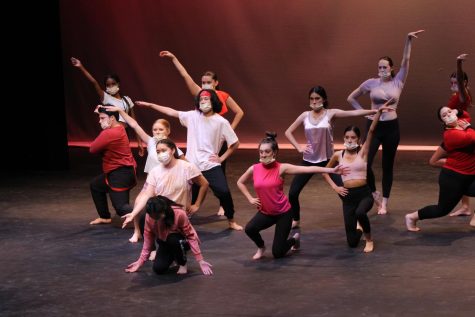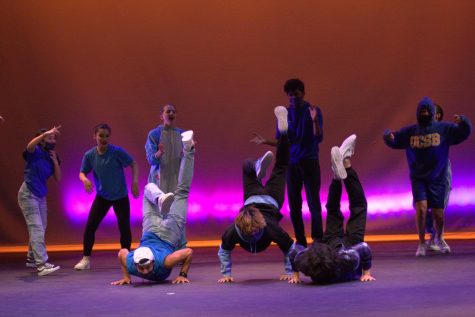Winter Dance Concert Helps “Re-envision” Society
Dance Company forms a flowing chain during Ashley Kao’s special piece. The white dresses symbolized innocence, contrasting the vibrant red, which signaled external dangers.
Darkness fills the room, the tension of suspense leaving the audience in silence. Suddenly, bright lights, and a beautifully-colored backdrop. On stage, 19 members, all in synchronized movement, mesmerize the audience. The music is captivating and the choreography takes you on a rhythmic adventure. The dancers’ motion: gentle, yet decisive. Swift, yet organized. Position to position, like a flock of birds migrating southbound, as the winter comes tumbling in.

The audience is in awe. The boys in the front cheer on the company, encouraging other audience members to join in. There are thuds of footsteps, spins, jumps, and leaps. The lights reflect off the dancers’ skin, and hair flows by like ribbons.
The Sage Creek Dance Program’s winter showcase, Re-envision, took place in the Performing Arts Center on December 9 and 10. With a total of two acts and 19 dances performed by both Dance Company and Dance 1, the event truly expressed dance as an art form.
This showcase visualized an escape from the path of despair through dance. As a whole, the performance conveyed a call for change.
The dances are the result of plentiful practice and physical prowess. Following over seven weeks of choreographing, designing and rehearsing, the culmination of these efforts was a concert of progressively flowing dances, 75% of them being student-generated according to Sage Creek dance instructor, Sarah Eichler.
It takes a backstage perspective to truly appreciate the hard work that the dancers take to yield such a result. Dance Company alumni, Jeslyn Chen, recognized the advantages of the process behind the pieces.

“Choreography is a really creative process that I’m in love with,” Chen said. “A person’s choreography is an accumulation of their dance experience and what they have learned in their dance journey.”
What better backstage perspective than actually performing in the concert. I was honored to be part of the Bobcat Boys, a long-running tradition where Dance Company and a group of boys have their own little section. With that, comes a chance for guys to dance, a tradition from “the conception of the program”: The Bobcat Boys.
Every Wednesday, rehearsal took place 3:45-4:45 p.m. or 2:45-3:45 p.m. in the dance room. The experience of learning choreography, practicing the routines and polishing the moves is unique to the sport.
A noteworthy topic to brush on is how refreshing it is to see a group of guys, with zero dance experience, get to have fun and enjoy the craft of dance. The art of dancing has a feminine connotation. Being in that group of boys and challenging the idea of dance as solely a female sport was inspiring to me.
“One downfall of the dance community is the stigma around male dancers–and thereby there are so few men in dance!” Eichler said. “Once they rehearse with us, and especially after they perform, they see how much fun we have in the dance studio and how much we learn about our bodies, dance and ourselves. How could you not have fun?”
Personally, what I saw was a rich and amazing bonding opportunity. The boys as a whole were proud of the result. We struggled, and it took many of us a long time to learn the dances. Many of us found ourselves practicing outside of rehearsals. Most of the guys ended up really comfortable with our partners by the end of it, and it turned out to be an experience that left us feeling like something was missing every Wednesday after the show had concluded.

“I would love to see more guys in dance because it’s really not a gender-specific sport or art and teaches a lot of things, for example, discipline,” Chen said. “Both of my brothers dance and they’re also both awesome people.”
Another highlight of the Winter performance was Ashley Kao’s Genius Project. Kao choreographed a piece that reaches out and conveys a sense of protection, challenging the dangers of our current society.
Eichler interpreted the piece’s impact beautifully.
“The piece began with a lot of chaotic, intense, highly rigorous movement and lifts, climaxed as dancers ran around the stage and presidents of clubs for students of color on our campus entered, and then ended with a warily hopeful message that ‘[we can] make our world more beautiful.’”
The inspiration was taken from the poem “Good Bones” by Maggie Smith. A reading of the poem was incorporated into the music, and it became an artistic rendition of our need for social justice. The result was a powerful depiction of an awakening from the moral wrongs of society.
Ashley’s piece concluded with a representative person of leadership in each of Sage Creek’s ethnic student unions. The presidents of Asian Student Union, Black Student Union, Movimiento Estudiantil Chicano de Aztlán (MEChA) and the Muslim Student Association had fists raised in empowerment at the end of her production. Kao is not only a prominent member of the Dance Company but also the president of the Asian Student Union.
Cheers and tears could be heard from the crowd, an atmosphere gracefully and meticulously crafted by the design of the piece.
“In my interpretations, Ashley’s piece really highlighted the chaos and torment of our society and the hope we must maintain and the fight we must fight to protect future generations and stop the downturn of our society today,” Eichler said. “Ashley’s piece was so powerful because of its message and also because it came from a student. I spoke to so many parents who were so touched by the fact that the younger generation has such a drive to better the world.”


